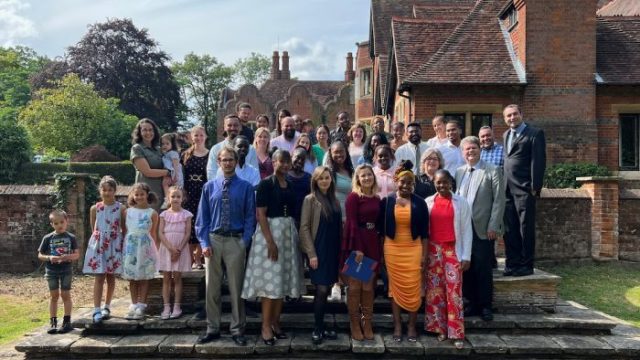A curriculum studied by millions around the world

Few publications within the Seventh-day Adventist Church have had as great an impact as the Adult Sabbath School Bible Study Guide (ABSG), commonly known as the “quarterly” in some parts of the world and the “lesson book” in others. With more than 15 million copies produced annually, its use today is certainly much broader than Adventist pioneer James White ever imagined as he penned those first studies atop a “dinner box” more than a century and a half ago.1
The original lessons were created to help Adventists progress in their understanding of the Bible prophecies that gave the Advent movement its impetus in the mid-nineteenth century. This emphasis has never been lost. Even now, millions of people around the world—in all age groups—study a particular Bible topic every week, then meet together in their Sabbath School classes to share and learn.
How Did It Start?
The original Bible study lessons were printed in the Youth’s Instructor2 in August 1852 after the Review and Herald office had acquired its first printing press. Shortly after, James White spent more than a month visiting groups of believers on the East Coast of the United States, traveling in a covered carriage with his wife, Ellen, and their 3-year old son, Edson. At noon, while the horses fed, he would sit down to continue writing the lessons for some 2,000 Advent believers.3
Today the production of the study guides has expanded to their being printed in 93 languages and distributed worldwide to millions of members in the church’s 13 administrative divisions.
Preparing a People
Early lesson topics focused on the prophecies in the book of Daniel, the sanctuary doctrine, and the three angels’ messages, encouraging members to prepare for and hasten Jesus’ appearing. In more recent years Sabbath School members studied all 66 books of the Bible systematically, Adventist fundamental beliefs, the Holy Spirit, stewardship, and healthful living.
“We cannot possibly target only one particular need regarding content or one preference of style among the incredible diversity we see in the world Adventist Church,” says Clifford Goldstein, senior editor of the Adult Sabbath School Bible Study Guide for 19 years. “It’s just too great a field. We have to focus on the Bible and its universal principles.”
Goldstein says his goal continues to be publishing “present truth” for church members today.
“We have to keep it interesting enough for those who have been lifelong Adventists,” he says, “but basic enough for those who have only started their journey.”
“I cannot guarantee that everyone uses it,” he continues, “but I know that millions do around the world. And that’s a feat in itself, because some undoubtedly find it too conservative, others too liberal, and yet others think it should be presented differently. Despite all that, it remains a great unifier. Wherever you go in the world, you will find a group with whom you can study the Bible,the same topic that you have been studying all week! It keeps us grounded and brings us together.”
Goldstein adds that local Sabbath School teachers play an important role in the success of the study guides. “The guide is just that—a guide—but the teacher is key,” he says. “The teacher can contextualize it, bring it to the level of those in the local group, apply it to relevant local issues, and make it as engaging and interesting as they choose to.”
The Sabbath School members themselves, Goldstein says, also must commit to studying the lessons and attending the study groups. The mission of the guides is fulfilled in the Sabbath School classrooms, he says, only when members engage in their study fully and practice the principles they learn in their communities.
A Sharing Tool
Many members value the study guides so highly that they “don’t have the heart” to throw them away, so they find ways to share them with others. Soraya Homayouni, associate editor of the study guides, discovered this firsthand while taking a course in creative writing as part of her master’s degree.
“A classmate who was not a member of our church said she was sure she recognized my name from somewhere,” Homayouni explains. “She asked me, ‘Don’t you edit Bible study guides?’
“‘How do you know?’ I responded.
“She told me that someone had given one to her on the topic of couples in the Bible as a wedding present. Then she smiled and said, ‘Of all the gifts I received for my wedding, the Bible study guide was the gift I loved best.’
“It was such a joy for me to realize that my work as associate editor of the ABSG reached individuals where it mattered.”
The Journey of the Bible Study Guides
The production journey of the guides is likely more multiplex than most people think. It begins soon after each General Conference session, when Sabbath School and Personal Ministries Department leaders from the church’s world divisions gather for an advisory and choose the study guide topics for the following five-year term. These topics are then approved by the General Conference Administration Committee. The editor chooses authors for each of the topics, who are given two years to write the lessons. The completed manuscripts then enter two cycles of reading, feedback, and editing by board-selected committees, the General Conference Biblical Research Institute, and ABSG department editors—after which the final formatting and copyediting is performed. At this point the final copy is sent to world church divisions for translation, printing, and distribution in the local fields.
“It’s about a five-year process for any one lesson to complete the production cycle and land in a church member’s hand for that quarter’s study,” Goldstein says.
Accessibility—a Work in Progress!
Not all church members have easy access to the lessons. In some world regions a member can walk up to the hospitality desk at church on a Sabbath morning and ask for as many study guides as there are members in their household—at no charge. Of course, members generally contribute to study-guide production expenses through their offerings. In other regions, if members don’t order and pay for all their required study guides for the next two quarters in advance, they will find it very difficult to acquire them later. In yet other areas, members seem to receive their booklets by entirely miraculous means, considering the challenges involved in transporting them from publishing houses to remote territories such as mountainous island villages.
Church leaders continue to study ways to resolve these accessibility issues, such as utilizing technology to provide online platforms to those who are able to access them.
“I always throw an extra copy of the study guide into my bag when I’m traveling,” says Goldstein, “just in case I don’t find WiFi where I’m going. But I usually study my lesson online or on the app. There are so many different apps and online sites for the lesson study; there should be no problem finding it. I think this is a good trend.”
A Consistent Mission
If he could change anything about the development of the study guides, Goldstein says he would “speed up the production process.”
Some might compare this sentiment to the objective of earlier lessons to “speed up” the return of Jesus. The mission, it seems, is still the same.
Whatever the study guides mean to church members individually today, they remain one of the great mainstays of the Adventist Church. An informed church is a church ready to share biblical truth. If members use this precious resource “to the full,” evidence indicates that it will keep us grounded, bring us together, and truly help us “speed things up” as we look forward to that great day!
1 Historical information in this article is taken from “Sabbath School Publications,” The Seventh-day Adventist Encyclopedia, “Sabbath School Publications” (Hagerstown, Md.: Review and Herald Pub. Assn, 1996), vol. 11, pp. 513-517.
2 https://www.adventistarchives.org/youths-instructor-editors
3 James White, in Advent Review and Sabbath Herald, May 6, 1852.
Penny Brink is contracted to Adventist World as a writer, editor, and coordinator for contextualized editions. She lives in Somerset West, South Africa.








